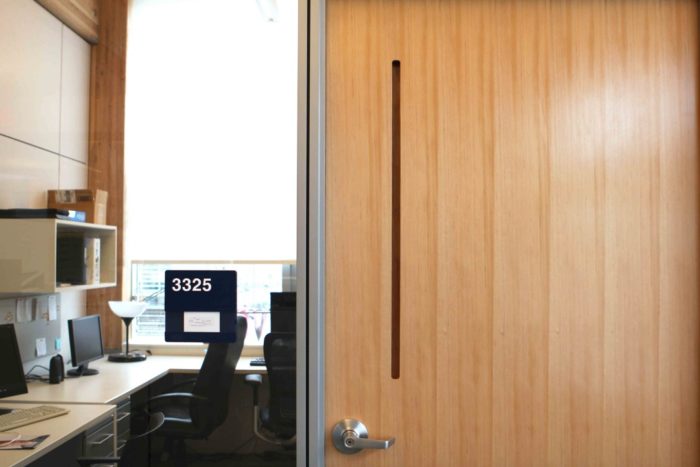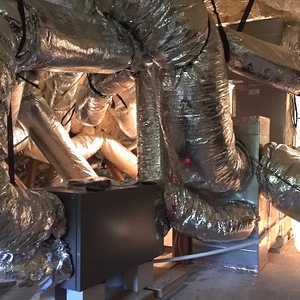Image Credit: VanAir
Image Credit: VanAir Moving air, but not noise. Air can move through passageways in the door, but the design impedes the movement of sound, according to VanAir Design.
Image Credit: VanAir Design
UPDATED
An interior door developed by students at the University of British Columbia provides a pathway for air between adjacent rooms, reducing pressure imbalances that can degrade the efficiency of forced-air heating and cooling systems.
The VanAir ventilated door allows the passage of air, but it also includes sound-dampening features that solve a problem common to houses with forced-air heating and cooling systems: how to equalize air pressure between rooms without sacrificing privacy.
Pressure imbalances are a well-known problem, as outlined by GBA senior editor Martin Holladay in this 2009 article.
Ideally, each room with a supply grille also would have a return-air grille. But to lower costs, many houses have a single, large return-air grille in a central location, like a hallway or living room. When interior doors are closed, it’s difficult for return air to find its way to the return grille. Air pressure in the closed room builds up, forcing air into wall and ceiling cavities, while return air is pulled from an unintended source, such as the attic.
HVAC contractors have several ways of getting around the problem, such as installing through-the-wall transfer grilles or crossover ducts between a ceiling grille in a bedroom, for example, and a ceiling grille in the hallway. But both of these options also allow the transmission of sound, an unattractive tradeoff.
That’s the problem that the VanAir door addresses.
The door is headed for production
VanAir Design is the brainchild of a half-dozen students who enrolled in a course in 2012 called New Venture Design at the University of British Columbia. They built their prototype doors and conducted both laboratory and site testing at the Centre for Advanced Wood Processing.
The company that sprang from that project now operates in Vancouver.
VanAir doors, which recently won a prototype award at an interior design show in Vancouver, will soon be going into production at Lynden Door, said Vick Yau, one of two principals at VanAir. The doors will be available through Alliance Door Products in paint grade or a number of wood veneers, including fir, oak, maple, birch, cherry, and hemlock.
Doors will be produced in any size, Yau said by email, with the most common size a standard 3-0 by 6-8. He said a final price list wasn’t yet available, but the doors would probably sell for between 15% and 20% more than a standard solid-core door.
A key consideration, as explained in Holladay’s blog, is how much free area is provided by a transfer grille (or in this case, a door) in order for it to be effective. Yau said the last prototype tested by VanAir had an equivalent open area of 50 square inches, which could provide 100 cubic feet per minute (cfm) of air at a pressure difference of 5 pascals, or 65 cfm at 2.5 pascals.
Yau originally said the door had 100 square inches of free area, but he said later he realized he had erred. The 50 square inches of free area is short of the 60 to 120 square inches that most bedrooms should have.
“We have recently commissioned a new testing lab to conduct tests on newer prototypes and on the production model, so I hope to give you more info/data down the road,” Yau said in a followup email. “We have built prototypes in the past that ranged from 36 square inches to 81 square inches in free open area. It is a matter of finding a balance between airflow and sound attenuation.”
Yau also said that tests found the VanAir door to have a Sound Transmission Class (STC) rating of 19, compared with the 21 STC of a solid-core door and the 14 STC of a hollow-core door. The higher the number, the better a material is at blocking sound.
Weekly Newsletter
Get building science and energy efficiency advice, plus special offers, in your inbox.














One Comment
Does the 50 free inches
Does the 50 free inches include the gap on the bottom?
Is the STC rating of the solid core and hollow core door provided by VanAir or are those "industry norms"? I ask because Trustile lists the STC rating of typical hollow core doors at 20-25 (http://www.trustile.com/technical-information/sound-doors/understanding-stc-ratings). Admittedly that may be in an application with a sill and not a gap on the bottom as is the case with most residential interior doors...
Log in or create an account to post a comment.
Sign up Log in